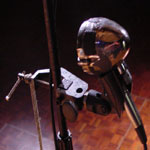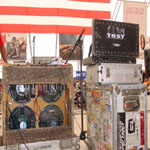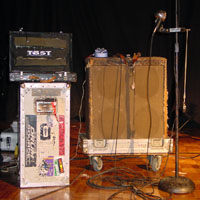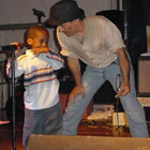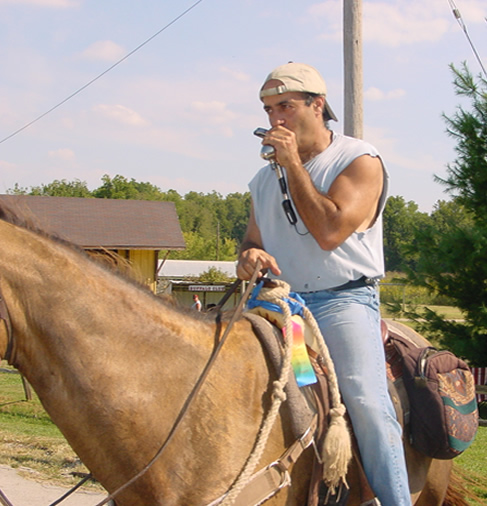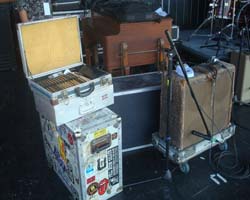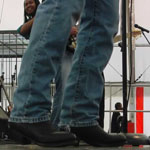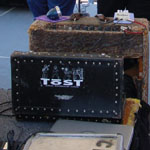Harmonica
This page starts with a personal bio. Then what I think are the first six things a new harmonica player should do. At the bottom of the page is a little something the equipment I use.
|
|||
|---|---|---|---|
I'm an accidental Harmonica Player. Loving the stage and "Off-Pop" Rock & Roll, as a high school senior I started carrying a harmonica everywhere. Stuck it in my pocket. No reason not to. While a camp counselor, hanging with friends that played guitar around the campfire, or in Baltimore's Marble Bar, I was ready and eager to play, like a ball game. After growing up on Baseball and Soccer fields, music and acting became a sports substitute. I played in the car, walking, sitting, in friend’s living rooms trying not to be too much of a pain in the ass. These are lessons #1 and 4 below. Carry it everywhere, no reason not to and don't be a "Gus", playing until you drive folks crazy. Do that alone and drive yourself. I started listening for music with Harmonica Players: Sam Myers, Muddy Waters, Paul Butterfield, Sonny Terry (a unique Sonny Terry story in a few weeks), Charlie McCoy, Magic Dick and his J. Geils Band, Norton Buffalo, Stevie Wonder, Larry Adler, The Fabulous Thunderbirds, Mark Ford. I saw the Nighthawks with Mark Wenner up close and personal, playing harmonica in a cool sweaty Rock & Roll Band; watched Bruce Springsteen often, once from the front row blasting through “Promised Land” in my face as if to say, “Here’s how you play this in a Rock & Roll Band!” little technique and perfect, dripping with his considerable passion. I attended jams in the Fells Point section of Baltimore with David Zee, Guy Phillips, Steve Hunt, Nick Nickens, Craig Hopwood, then joined a group that told me to put down the cow bell, my rhythm stunk, but that Harmonica is working. I listened to a lot of other lead/solo type of instruments: electric guitar, all the horns, organ and keyboards. The goal was to get a single note, play it clear, soft or loud, pretty or ugly, then play with a pro. Bob Grimm, a folk singer at Angel's Grotto in Towson, MD, invited me up to do a song and asked if I played professionally. Light bulb and lesson 4: Act like you can play. If this pro thought I was OK…
|
|||
The First Six Lessons1. Get a harmonica and carry it, in your pocket, on your person, everywhere. Not close by, but directly in your pocket or bag. Get an inexpensive Harmonica so you won't worry about sitting on it, getting it dirty, losing it, giving it to a kid, give it to a person you want to meet..."is that a harmonica in your pocket or are you ..." 2. Get a single note. I consider "pucker" style, the best initial way to do this. There are other methods like blocking holes with one's tongue, but for a beginner, I find the pucker method most useful. One can tilt the Harmonica, use your thumb or finger on the side of the mouth, anything to get that single note. Go from one note to the next, mixing up your patterns, concentrating on the pureness of the note, sound, tone. Listen to Willie Nelson's guy, Mickey Rafeal for beautiful single note sounds. Then listen to the Walter's, Big Walter Horton and Little Walter Jacob for tone, tone and more tone. Listen to saxophones. 3. Suck before you blow. Many of the cool sounds, especially early, are accomplished breathing in. Get used to it by inhaling for the first breath taken on the Harmonica. 4. Act like you know how to play. This also means don't be a jerk. Don't play (or not much) over vocals or other solos. Be polite to jam leaders. Playing on someone's stage, even at a Jam, is not a right enumerated in the constitution. Playing is icing on the cake at what should be a fun time out. Be a mensch! 5. Go for what you want on the instrument and listen to what you get. You may not get the exact thing you wanted to play and it may sound good anyway...if you listen. Funny thing, listening will take someone a long way in music. 6. Once you start playing with other musicians, choose the right Harmonica. Learn about 2nd position, "cross harp". If the band is in a certain key, use a harmonica labeled a fourth up to play in that key. To play in the key of A, use a D. To figure what the fourth is, in a very un-theoretical, simplistic way, start counting on the target key mentioned: A=1, B=2, C=3, D=4. Key of G: G=1, A=2, B=3, C=4, use a C harmonica to play in G. For F (Bb), and F# (B) it's a bit different. Use your fingers to count at first or you will mess it up. Don’t say I didn’t warn you. Now inhale (lesson 3) on the low end. The high notes can get irritating even with pros.
These points aren’t necessarily for theory folks, simply regular folks. There are other positions, stunt Harmonicas (see Lee Oskar’s special tunings), key relationships, techniques. For technical info there are a lot better folks than me. One place to find this information on line, are sites supported by The Society For The Preservation and Advancement Of The Harmonica: S.P.A.H. Harp-l is an on-line posting board with tons of great info and discussion, and believe it or not, stupid stuff too. The consistent thread that runs through every successful Harmonica player, Musician, Artist, is truth to who they are, communicating this truth and having fun.
|
|||
EquipmentI play through an original 1960 Fender Basman Amplifier, four 10" speakers. They're Jensons but they've been reconed several times. I have two microphones for harmonica playing, both have "astatic" styled casings with the "green bullet" element inside. I like how the volume control fits into those casings as opposed to actual green bullet casings. I also play through a Danelcto "Danecho" delay, and on rare occasions will toy with an octave box or other effects. I prefer Marine Band harmonicas and the Lee Oskar minor keyed harmonicas, however I'll play almost any harmonica available at any times. Hering, from Brazil are good. Even some less expensive Huangs do well for me. I'm not very picky. The Shure SM 58 vocal mic is a standard, sometimes an EV is nice, and I like a straight stand with a solid base.
|

